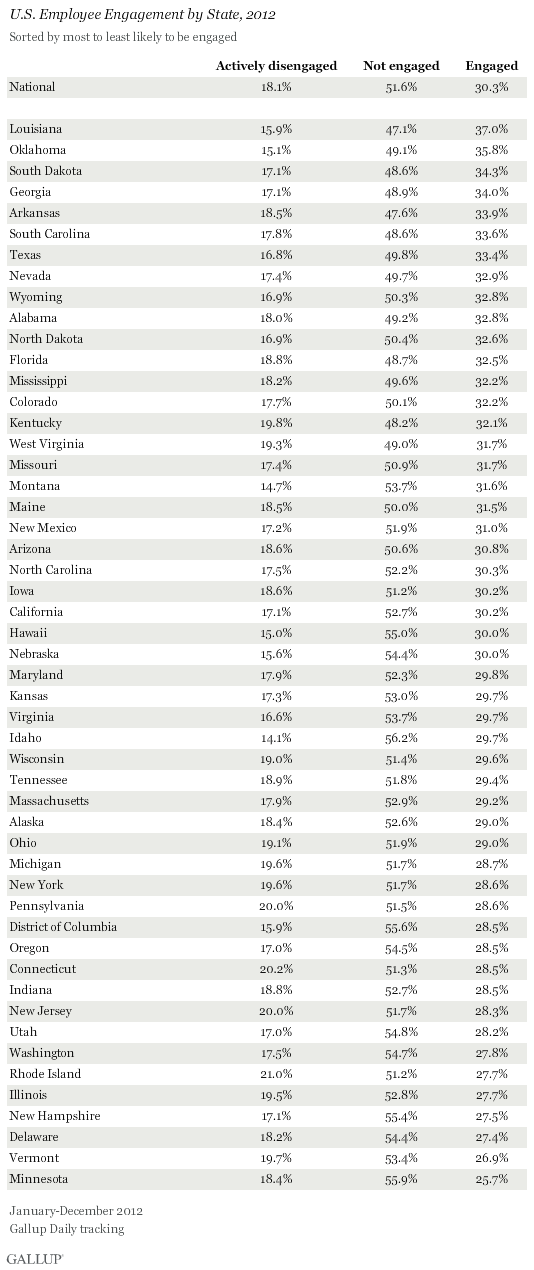WASHINGTON, D.C. -- Workers in Louisiana, at 37%, were the most likely in 2012 to be engaged in their jobs -- meaning they are involved in and enthusiastic about their work. Those in Minnesota, at 25.7%, were the least likely to be engaged at work.
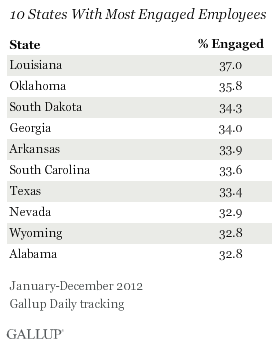
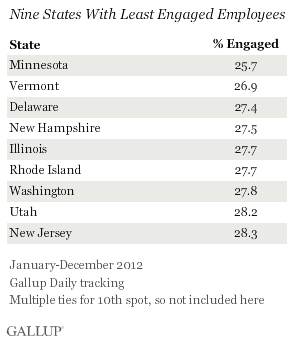
(For the full data on each state see page 2.)
These state-level data are based on a total of 151,284 daily surveys conducted as part of Gallup Daily tracking from January through December 2012 and include at least 506 employed residents in every state. These findings and more are available in Gallup's State of the American Workplace report, released June 11.
Gallup's employee engagement index -- which categorizes workers as engaged, not engaged, or actively disengaged -- is based on worker responses to 12 workplace elements with proven linkages to performance outcomes, including productivity, customer service, quality, retention, safety, and profit.
Engaged employees are involved in and enthusiastic about their work. Those who are not engaged are satisfied with their workplaces, but are not emotionally connected to them -- and these employees are less likely to put in discretionary effort. The actively disengaged workers are emotionally disconnected from their work and workplace and jeopardize the performance of their teams.
Beyond the differences between the states with the most and the least engaged workers, engagement does not vary dramatically nationwide. Still, seven of the 10 states where engagement is highest are in the South. But, there is no clear geographic pattern to where the states with the lowest engagement levels are located.
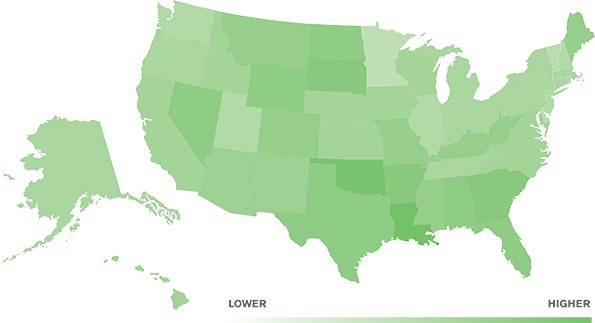
Workers in Rhode Island Most Likely to Be Actively Disengaged
Active disengagement, which can be detrimental to workplaces, is highest in Rhode Island, at 21% in 2012. At 14.1%, it is lowest in Idaho. Part of the reason Idaho workers are least likely to be actively disengaged is that they are most likely to fall into the middle category -- not engaged.
Most of the states where engagement is highest also appear on the list of states where active disengagement is lowest.

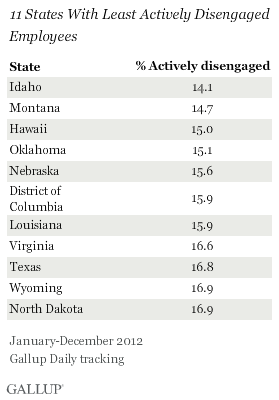
Fifty percent or more of workers in 39 states are not engaged in their jobs. And in the remaining 11 states, the percent of workers who are not engaged is nearly 50%.
Bottom Line
Gallup research has long-proven how vital employee engagement is to organizations big and small. Engaged employees are not only more productive at work, but also have better health habits, fewer chronic illnesses, and report more hiring at their companies.
Why engagement is higher in certain states than others is not entirely clear. It may be a reflection on the workplaces operating in those states. But, it could also be tied to broader socioeconomic and demographic trends across states. For example, baby boomers and those in Generation X are the least likely to be engaged in general, according to Gallup's just-published State of the American Workplace report. Thus, it could be that states where engagement is particularly low have a disproportionately high percentage of either baby boomers, Generation X'ers, or both.
The average size of employers in states may be another possible explanation for differing levels of engagement across states, as companies with fewer employees on average tend to have higher levels of engagement. But, further research is needed to determine the exact causes underlying the variation in engagement by state.
Regardless, for states like Rhode Island and Minnesota where engagement is lower and active disengagement is higher, workplace leaders should take note and look into improving their work environments in order to increase positive outcomes not just at their company, but also for their entire community.
Survey Methods
Results are based on telephone interviews conducted as part of Gallup Daily tracking Jan. 1-Dec. 31, 2012, with a random sample of 151,284 adults, aged 18 and older, living in all 50 U.S. states and the District of Columbia, selected using random-digit-dial sampling.
For results based on the total sample of national adults, one can say with 95% confidence that the maximum margin of sampling error is ±1 percentage point.
The margin of sampling error for most states is ±1 to ±2 percentage points, but is as high as ±4 points for states with smaller population sizes such as Alaska, Rhode Island, Vermont, Wyoming, North Dakota, South Dakota, Delaware, and Hawaii.
Interviews are conducted with respondents on landline telephones and cellular phones, with interviews conducted in Spanish for respondents who are primarily Spanish-speaking. Each sample includes a minimum quota of 400 cellphone respondents and 600 landline respondents per 1,000 national adults, with additional minimum quotas among landline respondents by region. Landline telephone numbers are chosen at random among listed telephone numbers. Cellphone numbers are selected using random-digit-dial methods. Landline respondents are chosen at random within each household on the basis of which member had the most recent birthday.
Samples are weighted by gender, age, race, Hispanic ethnicity, education, region, adults in the household, and phone status (cellphone only/landline only/both, cellphone mostly, and having an unlisted landline number). Demographic weighting targets are based on the March 2012 Current Population Survey figures for the aged 18 and older non-institutionalized population living in U.S. telephone households. All reported margins of sampling error include the computed design effects for weighting.
In addition to sampling error, question wording and practical difficulties in conducting surveys can introduce error or bias into the findings of public opinion polls.
For more details on Gallup's polling methodology, visit www.gallup.com.
